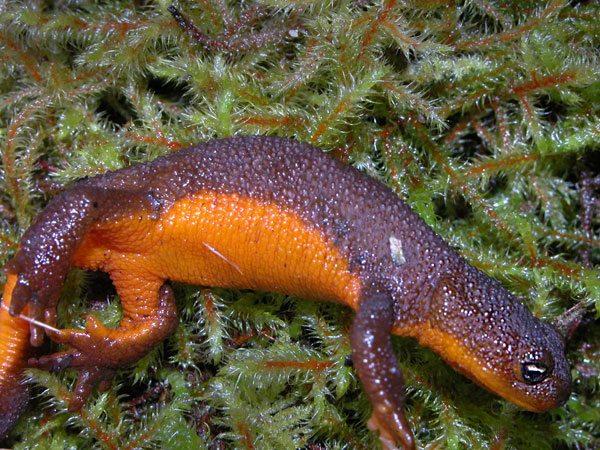The Mystery of Tetrodotoxin
Of all the naturally produced poison compounds
that are found in the world, tetrodotoxin (TTX) is one of the most
dangerous and is currently known to be found in seventeen different
orders of the biological tree of life (Gall et al. 2012). Gall et
al. (2012) suggests three main ideas that attempt to explain how TTX
was acquired in vertebrates such as Taricha granulosa. The first
idea is that the Rough-skinned Newt incorporates TTX from strains of
symbiotic bacteria that can already produce it. The second idea is
that TTX toxicity is the result of a buildup of the compound in the
newt’s tissues from eating prey that posses TTX. The third and final
idea is that tetrodotoxin is produced in the tissues of the
Rough-skinned newt (Gall et al. 2012).

Taricha granulosa as a species best fits into the third
hypothesis and has been shown to be able to synthesize its own TTX
and amazingly without the need for any complex dietary precursor
(Hanifin et al. 2002, Gall et al. 2012). This evidence was supported
in long-term lab studies where Rough-skinned newts, even when not
being fed a diet that contained TTX, were able to maintain and even
increase their TTX levels over time as well as replace any excreted
toxin (Gall et al. 2012, Moczydlowski 2012). The skin, ovaries, and
recently deposited eggs of the Rough-skinned Newt have high amounts
toxin while other tissues such as muscle and blood only contain
small amounts (Gall et al. 2012). Like any trait, the concentration
of TTX in different newt populations can vary largely and is thought
to be the result of the newts’ only predator the Garter snake. The
Garter snake has co-evolved a resistance to the tetrodotoxin, which
forces both species to keep developing stronger toxins and
resistances (Hanifin et al. 2002, Gall et al. 2012, Moczydlowski
2012). Another interesting fact of this co-evolution is scientists
have found that a
Gartner Snake can compare their resistance to a
newts’ toxicity when they try to eat it, and will leave prey alone
if they think that it might be too toxic to eat (B.C. Frog Watch
Program 2013). The picture on the right shows another
evolutionary charachteristic of the Rough-skinned Newt that
developed
with toxicity. The brightly![]() colored underbelly
of the newt signifies to other organisms
that it is highly poisonous and should not be eaten. Another tactic to limit predation employed by
Rough-skinned Newts is the production of toxic eggs which are lethal
to most would be predators. In fact the tertrodotoxin found in
Taricha granulosa makes it the most poisonous amphibian in the
entire Pacific Northwest (B.C. Frog Watch Program 2013).
colored underbelly
of the newt signifies to other organisms
that it is highly poisonous and should not be eaten. Another tactic to limit predation employed by
Rough-skinned Newts is the production of toxic eggs which are lethal
to most would be predators. In fact the tertrodotoxin found in
Taricha granulosa makes it the most poisonous amphibian in the
entire Pacific Northwest (B.C. Frog Watch Program 2013).
With the history of tetrodotoxin established, we can now look
at how it functions. The molecule has a very specific effect on
animal physiology. TTX targets the Na+
ion channels located in the
cell membranes of the nervous system and blocks them from
functioning (Moczydlowski 2012). This blockage results in the
termination of almost all motor function of the muscles and leads to
paralysis of the body (Moczydlowski 2012). Various experiments with
this toxin provided some of the first clear evidence for the
presence of ion channels inside of cell membranes, which helped to
support the theory of nerve action potential (Moczydlowski 2012).
TTX functions like a competitive inhibitor, meaning that it blocks
the active site of an ion channel from coming into contact and
binding with any Na+ molecules. This prevents the creation of the
correct electrochemical gradient needed for nerve function. The
blockage occurs because the TTX molecule goes through a series of
chemical interactions with the active site of the ion channel that
hold the molecule firmly in place, preventing proper ion channel
function (Moczydlowski 2012). Taricha granulosa newts can display a
range of tetrodotoxin from 600 to 26,000 M.U. (Moczydlowski 2012).
To put that into perspective, one M.U. is the amount of TTX that is
required to kill one adult mouse in only ten minutes (Moczydlowski
2012). Now it only requires a small amount of TTX to block the ion
channels of the cell membrane and with the large amount of toxin
that the Rough-skinned Newt holds, it has the ability to kill many
would be predators (Moczydlowski 2012).
Although the biosynthetic genes for the production of TTX
have not yet been found in the newt genome, we can still look
towards the possible future of this compound in Medicine
(Moczydlowski 2012). Even though tetrodotoxin can be deadly to
humans, it does show some promise as a possible drug for use in pain
management to treat some conditions of inflammatory and neuropathic
pain (Moczydlowski 2012).